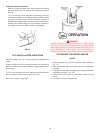
16
VENTING SYSTEM
HAVE VENTING SYSTEM CHECKED EVERY SIX MONTHS FOR
OBSTRUCTIONS AND/OR DETERIORATION IN VENT PIPING.
BLOWER ASSEMBLY MAINTENANCE
CAUTION
The air flow restrictor screen on the inlet side of the blower unit
should be checked periodically for any accumulation of dust and
lint. Any build up of dirt in the screen can result in insufficient
dilution air and excessive vent temperatures that could cause
heat damage to the PVC pipe or cause the thermal switch to
safely shut the unit down. Should this happen, the build up of the
lint/dirt needs to be cleaned.
The venter must be inspected four times a year. Points of
inspection are:
1. MOTOR - Motor must rotate freely.
2. WHEEL - Wheel must be clean of soot, ash, lint or any other
coating which inhibits either rotation or air flow. Remove all
foreign material from vent system before operating.
3. The pressure switch part inside the power venter must be
open and free from deposits of soot, carbon, etc.
For safety and satisfactory operation it is recommended that the
heater be checked once a year by a competent service person.
T & P VALVE
At least once a year, the temperature and pressure relief valve
must be checked to ensure that it is in operating condition. Lift
the lever at the top of the valve several times until the valve seats
properly and operates freely.
DANGER
THE WATER PASSING OUT OF THE VALVE DURING THIS
CHECKING OPERATION MAY BE EXTREMELY HOT. AVOID
CONTACT AND DISCHARGE SAFELY TO PREVENT WATER
DAMAGE.
If temperature and pressure relief valve on the appliance
discharges periodically, this may be due to thermal expansion
in a closed water system. Contact the water supplier or local
plumbing inspector on how to correct this situation. DO NOT
PLUG the temperature and pressure relief valve.
DRAINING (T)-FIG. 1
If the heater is to be shut off and exposed to freezing
temperatures, it must be drained. Water, if left in the tank and
allowed to freeze, will damage the heater.
• Turn off the gas and cold water inlet valve to the heater.
• Open a nearby hot water faucet and the heater drain valve.
• BE CAREFUL TO GRASP THE DRAIN VALVE HANDLE SO
THAT THE HAND IS NOT EXPOSED TO HOT WATER. IF
DESIRED, A HOSE MAY BE CONNECTED TO THE DRAIN
VALVE TO CARRY THE WATER AWAY.
DANGER: THE WATER MAY BE HOT.
• The drain valve must be left open during the shutdown period.
• To restart heater, refer to the FILLING instructions under
OPERATION.
Periodically open the drain valve and allow the water to run until
it flows clean. This will help prevent sediment build-up in the
tank.
It is normal for lime and scale deposits to form within the tank.
Such deposits will not be removed by periodic draining. It is
necessary to chemically delime the affected parts in water areas
where such deposits are encountered.
CONDENSATION
Water vapor can condense on the cooler surfaces of the tank
forming droplets, which drip into the fire or run out on the floor.
This is common at the time of startup after installation, during
periods of time when incoming water is very cold, or the heater
may be undersized for the requirements.
Droplets from the bottom of the flue may be due to corrosive
combustion products or improper venting. Check with your dealer
for more information.
CATHODIC PROTECTION - ANODE (FIG. 1)
The anode rod is used to protect the tank from corrosion. Most
hot water tanks are equipped with an anode rod. The submerged
rod sacrifices itself to protect the tank. Instead of corroding the
tank, water ions attack and eat away the anode rod. This does
not affect the water's taste or color. The rod must be maintained
to keep the tank in operating condition.
Anode deterioration depends on water conductivity, not
necessarily water condition. A corroded or pitted anode rod
indicates high water conductivity and should be checked and/or
replaced more often than an anode rod that appears to be intact.
Replacement of a depleted anode rod can extend the life of your
water heater. Inspection should be conducted by a qualified
technician, and at a minimum should be checked annually after
the warranty period.


















